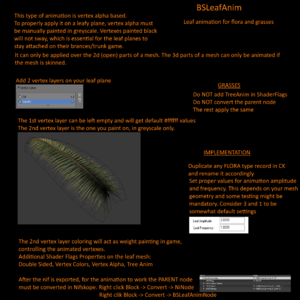Difference between revisions of "Arcane University:3D Art"
(→Expectation) |
|||
| Line 1: | Line 1: | ||
{{Trail}} | {{Trail}} | ||
| − | + | A '''3D artist''' can create shapes based on [[AU:Concept Art|Concept Art]], writing and discussions as well as what is required by the [[Arcane University:Animation|Animation]] and [[Arcane University:Implementation|Implementation]] teams. For example, if a certain object must have moving parts, detailed information on this is critical for the 3D artist to do their work effectively. For the Gamebryo Engine and the context of Skyrim, a 3D artist should take into account [[Arcane University:Mesh Polycount Comparisons|standard polycounts]] for their 3D models. | |
| − | + | ||
| − | + | ||
| − | + | ||
| − | A 3D artist can create shapes based on [[AU:Concept Art|Concept Art]], writing and discussions as well as what is required by the [[Arcane University:Animation|Animation]] and [[Arcane University:Implementation|Implementation]] teams. For example, if a certain object must have moving parts, detailed information on this is critical for the 3D artist to do their work effectively. For the Gamebryo Engine and the context of Skyrim, a 3D artist should take into account [[Arcane University:Mesh Polycount Comparisons|standard polycounts]] for their 3D models. | + | |
== General Workflow == | == General Workflow == | ||
| − | + | The artwork is taken and then, [[Arcane University:Blockout|blockout]] modeling starts. For the '''high-poly work flow''', the 3D artist [[Arcane University:Sculpting|sculpts]] a high-poly mesh. They then [[Arcane University:Baking|bake]] the high-poly details into the normal map of a low-poly version of the mesh. After the asset is [[Arcane University:Mesh Export to NIF|exported to NIF format]], it is given its physical properties such as [[Arcane University:Mesh Collisions|collision and physics]]. It may then be rigged/skinned to bones and [[Arcane University:Animation|animated]], if necessary. It is important to understand the Nif-specific rendering properties, shaders and texture set structure. | |
| − | + | ||
*[[Arcane University:Blockout|Blockout]] | *[[Arcane University:Blockout|Blockout]] | ||
| Line 19: | Line 14: | ||
|nottitlematch = Mesh_Export_to_NIF | |nottitlematch = Mesh_Export_to_NIF | ||
}} | }} | ||
| − | *[[Arcane University:Mesh Collisions|Mesh Collisions]] | + | *Adding [[Arcane University:Mesh Collisions|Mesh Collisions]] |
*[[Arcane University:Animation|Animation]] | *[[Arcane University:Animation|Animation]] | ||
| Line 40: | Line 35: | ||
=== Harvestables === | === Harvestables === | ||
=== LOD Objects === | === LOD Objects === | ||
| − | + | === Tilesets === | |
== Tool-specific Guidelines and Links == | == Tool-specific Guidelines and Links == | ||
===Resource Tools=== | ===Resource Tools=== | ||
* [[BSAopt]] to unpack Skyrim data files | * [[BSAopt]] to unpack Skyrim data files | ||
| + | |||
===Modeling Tools (most include sculpting and rigging features)=== | ===Modeling Tools (most include sculpting and rigging features)=== | ||
* [[Blender for Skyrim]] | * [[Blender for Skyrim]] | ||
* [[3DS Max for Skyrim]] | * [[3DS Max for Skyrim]] | ||
* [[Maya for Skyrim]] | * [[Maya for Skyrim]] | ||
| + | |||
===Sculpting Tools=== | ===Sculpting Tools=== | ||
* [[Z-Brush for Skyrim]] | * [[Z-Brush for Skyrim]] | ||
* [[Mudbox for Skyrim]] | * [[Mudbox for Skyrim]] | ||
| + | |||
===Rigging Tools/Animation=== | ===Rigging Tools/Animation=== | ||
* [[Havoc for Skyrim]] | * [[Havoc for Skyrim]] | ||
Revision as of 15:20, 24 April 2021
A 3D artist can create shapes based on Concept Art, writing and discussions as well as what is required by the Animation and Implementation teams. For example, if a certain object must have moving parts, detailed information on this is critical for the 3D artist to do their work effectively. For the Gamebryo Engine and the context of Skyrim, a 3D artist should take into account standard polycounts for their 3D models.
Contents
General Workflow
The artwork is taken and then, blockout modeling starts. For the high-poly work flow, the 3D artist sculpts a high-poly mesh. They then bake the high-poly details into the normal map of a low-poly version of the mesh. After the asset is exported to NIF format, it is given its physical properties such as collision and physics. It may then be rigged/skinned to bones and animated, if necessary. It is important to understand the Nif-specific rendering properties, shaders and texture set structure.
Basics - The Data Formats Nif (Meshes) and DDS (Textures)
- To review the specifics of the NIF data format used for meshes, check Nif Data Format.
- To review the specifics of the DDS data format used for textures, check DDS Data Format.
Asset-specific Tutorials
Weapons
- Nifskope Weapons Setup
- File:Tutorial skyrim bows from 3ds.pdf (Bows with 3ds and Nifskope)
DungeonKits & Architecture Kits
Armor
Misc Items
Statics
Trees
Harvestables
LOD Objects
Tilesets
Tool-specific Guidelines and Links
Resource Tools
- BSAopt to unpack Skyrim data files
Modeling Tools (most include sculpting and rigging features)
Sculpting Tools
Rigging Tools/Animation
- Havoc for Skyrim
- Outfit Studio for Skyrim
- Rigging with Blender 2.79
- Rigging Jewelry with Blender 2.79
Texturing Tools
- Gimp for Skyrim
- Photoshop for Skyrim
- Paint.Net for Skyrim
- Bodypaint in Creation Kit
- Material Editor for Skyrim
